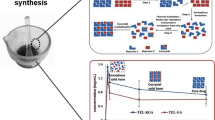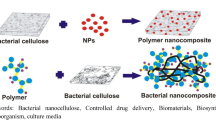Abstract
The purpose of this work was to develop and optimize gliclazide-loaded alginate–methyl cellulose mucoadhesive microcapsules by ionotropic gelation using central composite design. The effect of formulation parameters like polymer blend ratio and cross-linker (CaCl2) concentration on properties of gliclazide-loaded alginate–methyl cellulose microcapsules like drug encapsulation efficiency and drug release were optimized. The optimized microcapsules were subjected to swelling, mucoadhesive, and in vivo studies. The observed responses coincided well with the predicted values from the optimization technique. The optimized microcapsules showed high drug encapsulation efficiency (83.57 ± 2.59% to 85.52 ± 3.07%) with low T 50% (time for 50% drug release, 5.68 ± 0.09 to 5.83 ± 0.11 h). The in vitro drug release pattern from optimized microcapsules was found to be controlled-release pattern (zero order) with case II transport release mechanism. Particle sizes of these optimized microcapsules were 0.767 ± 0.085 to 0.937 ± 0.086 mm. These microcapsules also exhibited good mucoadhesive properties. The in vivo studies on alloxan-induced diabetic rats indicated the significant hypoglycemic effect that was observed 12 h after oral administration of optimized mucoadhesive microcapsules. The developed and optimized alginate–methyl cellulose microcapsules are suitable for prolonged systemic absorption of gliclazide to maintain lower blood glucose level and improved patient compliance.










Similar content being viewed by others
REFERENCES
Tripathi KD. Essential of medical pharmacology. 4th ed. New Delhi: Jaypee Brothers Medical; 1999.
Palmer K, Brogde R. Gliclazide—an update of its pharmacological properties and therapeutic efficacy in non-insulin dependent diabetes mellitus. Drugs. 1993;46:92–125.
Mailhot J. Efficacy and safety of gliclazide in the treatment of non-insulin dependent diabetes mellitus: a Canadian multicenter study. Clin Ther. 1993;15:1060–8.
Young JF, Wei GL, Lu R, Liu CX, Zheng BZ, Feng P. Bioavailability of gliclazide sustained release tablet in healthy volunteers. Asian J Pharmacodyn Pharmacokin. 2006;2:150–60.
Al-Kassas RS, Al-Gohary OMN, Al-Faadhel MM. Controlling of systemic absorption of gliclazide through incorporation into alginate beads. Int J Pharm. 2007;341:230–7.
Kristmundsottir T, Ingvarsdotir K. Ibuprofen microcapsules: the effect of production variables on microcapsule properties. Drug Dev Ind Pharm. 1990;20:769–78.
Chowdary KPR, Srinivas Rao S. Mucoadhesive microspheres and microcapsules: current status. Indian J Pharm Sci. 2005;67(2):141–50.
Garg S, Vasir JK, Tambweker K. Bioadhesive microspheres as a controlled drug delivery system. Int J Pharm. 2003;255:13–22.
Nayak AK, Maji R, Das B. Gastroretentive drug delivery systems: a review. Asian J Pharm Clin Res. 2010;3(1):2–10.
Nayak AK, Malakar J, Sen KK. Gastroretentive drug delivery technologies: current approaches and future potential. J Pharm Edu Res. 2010;1(2):1–12.
Carvalho FC, Bruschi ML, Evangelista RC, Gremiao MPD. Mucoadhesive drug delivery systems. Brazilian J Pharm Sci. 2010;46:1–17.
Chowdary KPR, Rao YS. Mucoadhesive microspheres for oral controlled drug delivery. Biol Pharm Bull. 2004;27:1717–24.
Dhanaraju MD, Sundar VD, Nandha Kumar S, Bhaskar K. Development and evaluation of sustained delivery of diclofenac sodium from hydrophilic polymeric beads. J Young Pharmacist. 2009;1(4):301–4.
Kikuchi A, Kawabuchi M, Sungihara M, Okano TS. Pulsed dextran release from calcium alginate. J Control Release. 1997;47:21–9.
George M, Abraham TE. Polyionic hydrocolloids for the intestinal delivery of protein drugs: alginate and chitosan—a review. J Control Release. 2006;114:1–14.
Smidsrod O, Draget KI. Chemistry and physical properties of alginates. Carbohydr Eur. 1996;14:6–13.
Patel YL, Sher P, Pawar AP. The effect of drug concentration and curing time on processing and properties of calcium alginate beads containing metronidazole by response surface methodology. AAPS PharmSciTech. 2006;7(4): Article 86.
Shilpa A, Agarwal SS, Rao AR. Controlled delivery of drug from alginate matrix. J Macromol Sci Polym Rev. 2003;43:187–221.
Llanes F, Ryan DH, Marchessault RH. Magnetic nanostructured composites using alginates of different M/G ratios as polymeric matrix. Int J Biol Macromol. 2000;27:35–40.
Kroll E, Winnik FM, Ziolo RF. In situ preparation of nanocrystalline γ-Fe2O3 in iron (II) crosslinked alginate gels. Chem Mater. 1996;8:1594–6.
Rane Y, Mashru R, Sankalia M, Sankalia J. Effect of hydrophilic swellable polymers on dissolution enhancement of carbamazepine solid dispersion studied using response surface methodology. AAPS PharmSciTech. 2007;8(2):1–11.
Prajapati SK, Tripathi P, Ubaidulla U, Anand V. Design and development of gliclazide mucoadhesive microcapsules: in vitro and in vivo evaluation. AAPS PharmSciTech. 2008;9(1):224–30.
Hamed E, Sakr A. Application of multiple response optimization technique to extended release formulations design. J Control Release. 2001;73:329–38.
Ye G, Wang S, Heng PWS, Chen L, Wang C. Development and optimization of solid dispersion containing pellets of itraconazole prepared by high shear pelletization. Int J Pharm. 2007;337:80–7.
Chowdary KPR, Rao YS. Design and in vitro and in vivo evaluation of mucoadhesive microcapsules of glipizide for oral controlled release: A technical note. AAPS PharmSciTech. 2003;4(3): Article 39.
Venkidesh R, Pal DK, Mohana LS, Saravanakumar A, Mandal SC. Antidiabetic activity of Smilax chinensis L. extract in streptozotacin-induced diabetic rats. Int J Phytopharm. 2010;1(2):16–21.
Karasulu E, Karasulu HY, Ertan G, Kirilmaz L, Guneri T. Extended release lipophilic indomethacin microspheres: formulation factors and mathematical equations fitted drug release rates. Eur J Pharm Sci. 2003;19:99–101.
Higuchi T. Mechanism of sustained action medication. Theoretical analysis of rate of release of solid drugs dispersed in solid matrices. J Pharm Sci. 1963;52:1145–9.
Peppas NA. Analysis of Fickian and non Fickian drug release from polymers. Pharm Acta Health. 1985;60:110–1.
Peppas NA, Koresmeyer RW. Dynamically swelling hydrogels in controlled released applications. In: Peppas NA, editor. Hydrogels in medicine and pharmacy. 3rd ed. Boca Raton: CRC; 1986. p. 109–36.
Sharma VK, Bhattacharya A. Release of metformin hydrochloride from ispaghula-sodium alginate beads adhered on cock intestinal mucosa. Indian J Pharm Edu Res. 2008;42(4):365–72.
Kim M-S, Kim J-S, You Y-H, Park HJ, Lee S, Park J-S, et al. Development of optimization of a novel oral controlled delivery system for tamsulosin hydrochloride using response surface methodology. Int J Pharm. 2007;341:97–104.
Ko JA, Park HJ, Park YS, Hwang S-J, Park JB. Chitosan microparticle preparation for controlled drug release by response surface methodology. J Microencapsul. 2004;20:791–7.
Nutan MTH, Soliman MS, Taha EI, Khan MA. Optimization and characterization of controlled release multi-particulate beads coated with starch acetate. Int J Pharm. 2005;294:89–101.
Ostberg T, Graffner C. Calcium alginate matrices or oral multiple unit administration: II. Influence of calcium concentration, amount of drug added and alginate characteristics on drug release. Int J Pharm. 1994;111:271–82.
ACKNOWLEDGEMENTS
One of the authors is thankful to Dr. R M Dubey, Vice Chancellor, IFTM University for providing necessary facilities for animal experiments.
Author information
Authors and Affiliations
Corresponding author
Additional information
Guest Editors: Michael Repka, Joseph Reo, Linda Felton, and Stephen Howard
Rights and permissions
About this article
Cite this article
Pal, D., Nayak, A.K. Development, Optimization, and Anti-diabetic Activity of Gliclazide-Loaded Alginate–Methyl Cellulose Mucoadhesive Microcapsules. AAPS PharmSciTech 12, 1431–1441 (2011). https://doi.org/10.1208/s12249-011-9709-8
Received:
Accepted:
Published:
Issue Date:
DOI: https://doi.org/10.1208/s12249-011-9709-8




